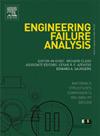Fatigue failure analysis and life prediction of forged 6061 aluminum alloy wheel hubs based on precipitate size effects and multiaxial stress modeling
IF 5.7
2区 工程技术
Q1 ENGINEERING, MECHANICAL
引用次数: 0
Abstract
Forged aluminum alloy wheel hubs are susceptible to premature fatigue failure under multiaxial loading in automotive applications. This study aims to address these challenges by developing a fatigue life prediction model that incorporates the crack initiation mechanisms specific to forged 6061 aluminum alloy. The microstructure and mechanical properties of the material were thoroughly characterized, revealing that cracks typically initiate at surface defects and precipitate-matrix interfaces. The grain sizes are refined to 50–100 μm, and a uniform precipitate distribution is obtained by dynamic recrystallization during the spinning process, thereby enhancing the strength–ductility synergy. Fractographic analysis revealed crack initiation at surface defects or precipitate–matrix interfaces. A three-stage failure mechanism “precipitate size–interfacial stress–microvoid evolution” is proposed: (I) stress concentration caused by precipitates exceeding the critical size, (Ⅱ) debonding driven by interfacial stress, and (Ⅲ) crack nucleation induced by microvoid evolution. To improve the accuracy of fatigue life predictions, a modified Basquin equation is combined with the critical plane method, integrating a fatigue stress concentration index (FSCI) and a life sensitivity coefficient (η = 0.085). The model demonstrates high predictive accuracy, with a maximum deviation of −1.8 % and an average error of less than 2 % compared to simulation results. The FSCI-based model gives a reliable prediction on the fatigue life exceeding 107 cycles at operational stress amplitude below 140 MPa.

基于析出相尺寸效应和多轴应力模型的锻造6061铝合金轮毂疲劳失效分析与寿命预测
锻造铝合金轮毂在汽车多轴载荷作用下易发生过早疲劳失效。本研究旨在通过开发一种疲劳寿命预测模型来解决这些挑战,该模型包含了锻造6061铝合金特有的裂纹起裂机制。对材料的微观结构和力学性能进行了全面的表征,表明裂纹通常起源于表面缺陷和沉淀-基体界面。将晶粒细化至50 ~ 100 μm,纺丝过程中通过动态再结晶使析出相分布均匀,增强了强度-塑性协同效应。断口分析显示裂纹起源于表面缺陷或沉淀-基体界面。提出了“析出物尺寸-界面应力-微孔洞演化”的三阶段破坏机制:(1)析出物超过临界尺寸引起的应力集中,(Ⅱ)界面应力驱动的脱粘,(Ⅲ)微孔洞演化引起的裂纹成核。为了提高疲劳寿命预测的准确性,将修正Basquin方程与临界平面法相结合,将疲劳应力集中指数(FSCI)与寿命敏感系数(η = 0.085)相结合。该模型具有较高的预测精度,与仿真结果相比,最大偏差为- 1.8%,平均误差小于2%。基于fsci的模型可以可靠地预测在140mpa以下应力幅值下超过107次的疲劳寿命。
本文章由计算机程序翻译,如有差异,请以英文原文为准。
求助全文
约1分钟内获得全文
求助全文
来源期刊

Engineering Failure Analysis
工程技术-材料科学:表征与测试
CiteScore
7.70
自引率
20.00%
发文量
956
审稿时长
47 days
期刊介绍:
Engineering Failure Analysis publishes research papers describing the analysis of engineering failures and related studies.
Papers relating to the structure, properties and behaviour of engineering materials are encouraged, particularly those which also involve the detailed application of materials parameters to problems in engineering structures, components and design. In addition to the area of materials engineering, the interacting fields of mechanical, manufacturing, aeronautical, civil, chemical, corrosion and design engineering are considered relevant. Activity should be directed at analysing engineering failures and carrying out research to help reduce the incidences of failures and to extend the operating horizons of engineering materials.
Emphasis is placed on the mechanical properties of materials and their behaviour when influenced by structure, process and environment. Metallic, polymeric, ceramic and natural materials are all included and the application of these materials to real engineering situations should be emphasised. The use of a case-study based approach is also encouraged.
Engineering Failure Analysis provides essential reference material and critical feedback into the design process thereby contributing to the prevention of engineering failures in the future. All submissions will be subject to peer review from leading experts in the field.
 求助内容:
求助内容: 应助结果提醒方式:
应助结果提醒方式:


